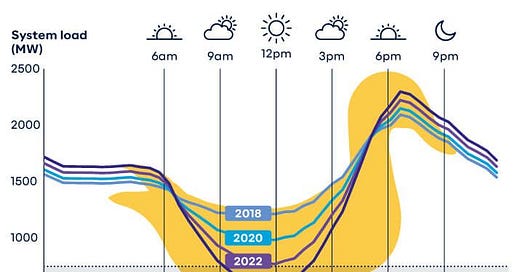Quick Insight: what do ducks have to do with revenues from solar
Or understanding how we can make the large scale solar roll out work
We need to change how we think about our electricity grid.
Using more renewables to generate electricity is not only necessary if we are to achieve net zero, but they can make financial sense as well. But, the shift to more renewables is going to massively change how our electricity grid works. We need to start investing in this new grid now, anticipate the challenges and solve them in a financially viable way.
Don’t assume that just building more wind and solar is going to fix the challenge on its own. But equally, don’t say ‘this is too hard, let’s give up now’.
And don’t forget to read our Notes posts - where we highlight key newsflow and reports that matter for Sustainability Finance
Solar is probably going to become our core renewable electricity generation technology. It's simple, it works in lots of situations, and it's getting cheaper. One challenge we need to face up to is 'too much of a good thing', when our solar panels all produce their maximum output at the same time, pushing spot electricity prices down close to zero.
While the marginal cost of producing the extra unit of electricity from a solar panel is very low (the raw materials are free), the upfront capital cost is not trivial. Investors still need to earn a fair return on their investment, or the money will not flow. And financial return is harder to deliver if revenues frequently head toward zero. The Duck curve helps us to understand this, and it helps us start to think about solutions. And be assured, solutions do exist.
The big theme: The twin aims of 'electrify everything possible' and 'make our electricity green' lie at the heart of most countries plans to achieve net zero and to decarbonise their economies. But, delivering on this is not just a case of building more wind and solar (plus geothermal and hydro). Our current electricity grid, and how we manage our electricity flows, is based on a system that Thomas Edison (arguably the father of electricity for all) would recognise, and he died in 1931. There are a lot of changes coming, which we need to anticipate and plan for. The electricity grid of the future will look very different.And before you ask - yes, there are ducks involved. A useful tool in understanding what higher levels of solar generation can mean for the demand for electricity from other sources is called the duck curve. And yes, it does look a bit like a duck. It shows the difference between solar generation (supply) and electricity demand.
In some countries/regions there is so much solar generation during the sunny part of the day, that very little other electricity supply is needed. And this is going to happen more and more. This might sound like a good thing. After all solar is low carbon, just the type of electricity we need more of. And it is good, but this also creates challenges.
The first one we already know - too much solar supply can, if not properly managed, push the price that the solar generating company gets down close to, or even below zero. This is something that many states in Australia are very familiar with.
The other challenge is that the steep ramp up in supply needed in the early evening puts real pressure on grid stability.
The good news is that we have solutions, including interconnectors to share the surplus electricity and battery storage to move the supply into the peaks, when net demand is high. It's important that we recognise the challenges that more solar will bring, and that we start investing in solutions.
You can read more in a recent blog we wrote - you can find it here.





